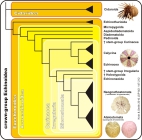
| Introduction | | Search taxa | | Taxon tree | | Taxon match | | Checklist | | Literature | | Stats | | Photogallery | | OBIS Vocab | | Log in |
CaRMS taxon detailsCarinacea
510517 (urn:lsid:marinespecies.org:taxname:510517)
Kroh & Smith, 2010
accepted
Infraclass
marine,
recent + fossil
Not documented
Description This group units the traditional groups of Camarodonta, Stirodonta and Irregularia. Although primitive irregular...
Description This group units the traditional groups of Camarodonta, Stirodonta and Irregularia. Although primitive irregular echinoids all have keeled teeth, cassiduloids retain teeth only in the earliest developmental stages and clypeasteroids have modified wedge-shaped teeth, holasteroids and spatangoids have secondarily lost their lantern and show no trace of a lantern at any stage. [details]
Kroh, A.; Mooi, R. (2024). World Echinoidea Database. Carinacea. Accessed through: Nozères, C., Kennedy, M.K. (Eds.) (2024) Canadian Register of Marine Species at: https://www.marinespecies.org/CaRMS/aphia.php?p=taxdetails&id=510517 on 2024-04-24
Nozères, C., Kennedy, M.K. (Eds.) (2024). Canadian Register of Marine Species. Carinacea. Accessed at: https://marinespecies.org/carms/aphia.php?p=taxdetails&id=510517 on 2024-04-24
context source (Hexacorallia)
Fautin, Daphne G. (2013). Hexacorallians of the World. (look up in IMIS) [details]
context source (PeRMS) Solís-Marín, F. A.; Alvarado, J. J.; Abreu-Pérez, M.; Aguilera, O.; Alió, J.; Bacallado-Aránega, J. J.; Barraza, E.; Benavides-Serrato, M.; Benítez-Villalobos, F.; Betancourt-Fernández, L.; Borges, M.; Brandt, M.; Brogger, M. I.; Borrero-Pérez, G. H.; Buitrón-Sánchez, E.; Campos, L. S.; Cantera, J.; Clemente, S.; Cohen-Renjifo, M.; Coppard, S.; Costa-Lotufo, L. V.; del Valle-García, R.; Díaz, Y.; Díaz de Vivar, M. E.; Díaz-Martínez, J. P.; Durán-González, A.; Epherra, L.; Escolar, M.; Francisco, V.; Freire, C. A.; García-Arrarás, E.; Gil, D. G.; Guarderas, P.; Hadel, V. F.; Hearn, A.; Hernández, J. C.; Hernández-Delgado, E. A.; Herrera-Moreno, A.; Herrero-Pérezrul, M. D.; Hooker, Y.; Honey-Escandón, M. B. I.; Lodeiros, C.; Luzuriaga, M.; Manso, C. L. C.; Martín, A.; Martinez, M. I.; Martínez, S.; Moro-Abad; Mutschke, E.; Navarro, J. C.; Neira, R.; Noriega, N.; Palleiro-Nayar, J. S.; Pérez, A. F.; Pérez-Ruzafa, A.; Prieto-Rios, E.; Reyes, J.; Rodríguez, R.; Rubilar, T.; Sancho-Mejía, T.; Sangil, C.; Silva, J. R. M. C.; Sonnenholzner, J. I.; Ventura, C. R.; Tablado, A.; Tavares, Y.; Tiago, C. G.; Tuya, F.;Williams, S. M. (2013). Appendix. <em>In: J. J. Alvarado & F. A. Solís-Marín (eds), Echinoderm Research and Diversity in Latin America.</em> pp. 471-510. Springer; Berlin & Heidelberg. page(s): 543-654. [details] basis of record Kroh, A. & Smith, A.B. (2010): The phylogeny and classification of post-Palaeozoic echinoids. Journal of Systematic Palaeontology, 8/2: 147-212., available online at http://www.informaworld.com/openurl?genre=article&issn=1477-2019&volume=8&issue=2&spage=147 page(s): 170 [details] From editor or global species database
Classification Mongiardino Koch et al. (2022), based on a large phylogenomic study, reassigned Salenioida from Calycina to Echinacea because saleniids were reseloved as sistergroup to Camarodonta+Stomopneustoida in their analysis. [details]Classification Although represented here as sister groups, Euechinoidea, Carinacea and Irregularia actually form a set of nested clades. Due to the limitations of WoRMS this cannot be reflected in the database at present. [details] Description This group units the traditional groups of Camarodonta, Stirodonta and Irregularia. Although primitive irregular echinoids all have keeled teeth, cassiduloids retain teeth only in the earliest developmental stages and clypeasteroids have modified wedge-shaped teeth, holasteroids and spatangoids have secondarily lost their lantern and show no trace of a lantern at any stage. [details] |
